Is it safe to exercise if you have diabetes? What are the dos and don’ts?
Here’s why exercise can potentially wean you off insulin treatment and what the experts say about weight loss, and protein and muscle-building supplements for those with diabetes. Also, you may want to stay away from artificial sweeteners.
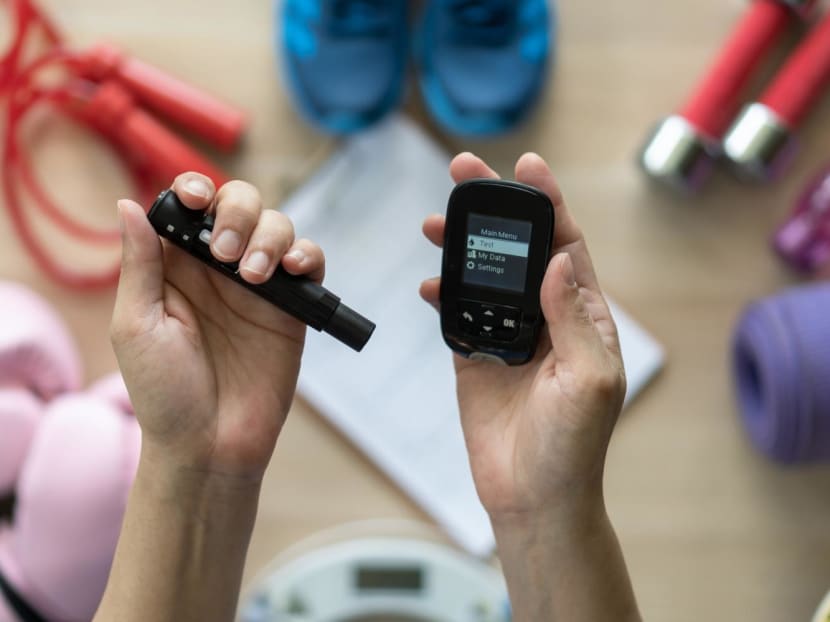
(Photo: iStock/Chinnapong)

This audio is generated by an AI tool.
Exercise can get tricky if you’re diagnosed with diabetes mellitus, which includes both Type 1 and 2 diabetes, and you have to watch your blood sugar or glucose level during your jog or session in the gym.
If your blood glucose level drops too low, you risk developing hypoglycaemia, which can bring on signs such as shakiness, lightheadedness, an irregular heart beat and headache – not good if you’re out brisk walking and you faint.
Go too high and you could develop hyperglycaemia – a very real concern for many with the more common Type 2 diabetes. The main symptoms of hyperglycaemia include increased thirst, hunger and urination. If left untreated, the consequences can be dire and can result in a diabetic coma and damage to organs such as the eyes, kidneys, nerves and heart.
It is enough to overwhelm those living with diabetes when all they want to do is take a walk in the park or roll out a mat for yoga. And we haven’t even factored in the fatigue, low energy and other health conditions that many such patients experience.
But exercise can be key to helping you better manage your blood glucose level, hit that Goldilocks sweet spot – and even reduce your reliance on insulin treatment, said experts.
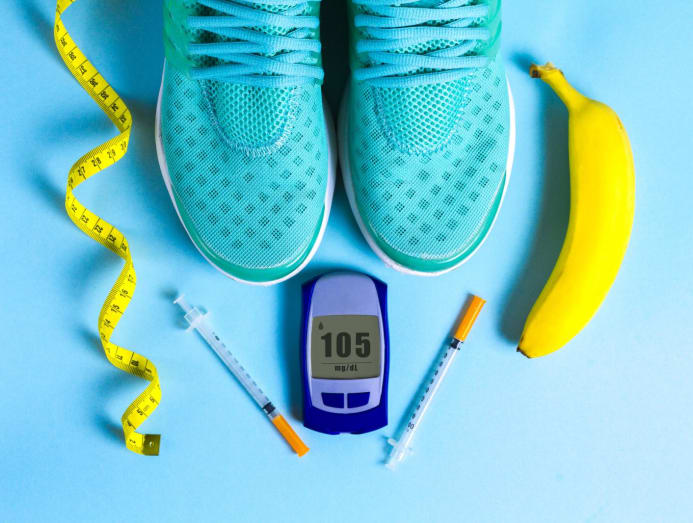
HOW DOES EXERCISE HELP WITH BLOOD GLUCOSE CONTROL?
"In individuals who are overweight and have Type 2 diabetes, reducing their body weight by 7 per cent to 10 per cent will dramatically improve blood sugar by making them more sensitive to the effects of insulin,” said Professor Tai Ee Shyong, the director of the National University of Singapore’s Centre for Chronic Disease Prevention & Management.
Hate it or love it, exercise is the key. “Muscle contractions during exercise allow body cells to take up glucose for energy, regardless of insulin availability,” said Cheryl Tan, a health coach with Alexandra Hospital’s Well Programme. Furthermore, insulin sensitivity is increased during exercise and up to 24 hours or more afterwards, she said.
Chermine Tan, a senior physiotherapist from Allium Healthcare, explained that “when your cells are more responsive to insulin, they can better take up glucose from the bloodstream, leading to lower blood sugar levels”.
And it’s not only during exercise that glucose gets used by your body for energy. “After exercise, your muscles continue to take up glucose for recovery and replenishment, further stabilising blood sugar levels,” she said.

BUT HOW DO I EVEN CONVINCE MYSELF TO BEGIN EXERCISING?
Many people living with diabetes may also have other health conditions such as joint pain, heart disease, kidney disease, weight issues or poor vision that pose considerable barriers to exercise, said Prof Tai.
They may also be older and have been sedentary, so they may not know how to go about starting a fitness routine. Then, there’s the psychological hurdle to consider as well. “Motivation is the hardest part. Some people just hate the idea of exercise," said Prof Tai.
But convincing these exercise-adverse individuals to lift a dumbbell can happen. It starts by helping them realise they have this emotional response to exercise and explore why they have this response, said Prof Tai. “Then, we help them find ways to overcome this initial emotional response, so that they can think about why they do this.”
In most cases, the motivation to exercise isn’t merely to improve health, said Prof Tai. “I don’t talk to my patients about exercise or physical activity to treat or prevent diabetes. I ask them to think about what they want to be able to do (for example, climb a flight of stairs to cross an overhead bridge, or lift a 7kg suitcase into an overhead compartment in the plane) and work towards that goal.”
DON’T PHYSICAL ACTIVITIES SUCH AS STAIR CLIMBING AND HOUSEHOLD CHORES COUNT AS EXERCISE?
The American Diabetes Association recommends that people with diabetes get at least 150 minutes of moderate-intensity exercise weekly. The good news is, yes, you can count physical activities such as taking the stairs and walking to dabao (buy takeaway) chicken rice as part of this quota, said Cheryl.
“As long as they are activities that work the large muscles, increase heart rate and make you respirate harder – almost any form of physical activity is beneficial," she said.
What about making the entire quota of 150 minutes per week all about physical activities? While you may break into a sweat from changing the bed sheets, it’s not high enough of an intensity to match that of resistance training with weights, or aerobic exercises such as running, swimming and cycling, said Chermine.
It’s akin to boiling water. When you turn up the heat, the water boils faster. Similarly, when you perform an activity at a higher intensity, you increase your body’s demand for glucose.

Moreover, exercise can be planned and scheduled, which gives you better control over when and how much physical activity is performed, said Chermine. “This predictability makes it easier for those with diabetes to manage blood sugar levels by adjusting their insulin or medication doses, carbohydrate intake or other factors accordingly.”
But don’t rule out physical activities just yet. “It is easy to accumulate and include activities such as taking public transportation rather than driving, walking to the market instead of taking the bus,” said Prof Tai. Moreover, “exercise is a little harder for some as they must make time for it”, especially those in the lower socio-economic groups. “If you work two jobs, it’s hard to find the energy to exercise,” he said.
OVERCOMING REAL-LIFE BARRIERS TO EXERCISE
If you’ve been recently diagnosed with diabetes mellitus and aren’t sure how to start being active, we’ve got your back. Here are the experts’ advice on some common scenarios that you may face:

Scenario 1: I’m not sure what I should take note of
Monitor your blood glucose level before, during and after exercise as you don’t want to faint mid-workout (due to hypoglycaemia) or risk damaging organs such as the kidneys, heart, eyes and nerves in the long run (due to hyperglycaemia).
Before exercise: If you’re on insulin or other blood glucose-lowering medications, check that your blood glucose level is within the safe range (usually 100mg/dL to 250mg/dL or 5.6mmol/L to 13.9mmol/L) 15 to 30 minutes pre-exercise, said Mary-ann Chiam, a senior principal dietitian with Allium Healthcare. You don’t have to take such precautions if you’re not taking medication, she said.
Hypoglycaemia generally occurs with treatments that involve insulin or other glucose-lowering medications. If your blood glucose level is low, see Scenario No. 2 on how to tackle it. Or it may be a matter of exploring other medications and adjusting the instructions.
“For individuals with Type 2 diabetes, there are some medications that do not cause hypoglycaemia,” said Prof Tai. Or “it may be a question of delaying some of your medication until after exercise when you are ready to eat. For Type 1 patients, they may need to adjust their insulin”. It is best to discuss with your doctor before making any changes.
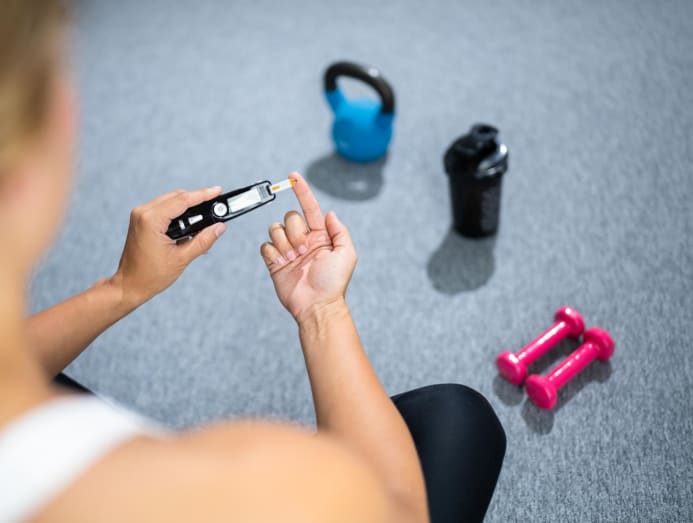
The other thing to note is ketones in your urine, said Chermine. “Ketones are produced when your body breaks down fat for energy and their presence indicates that your body doesn't have enough insulin to control your blood sugar levels.” If you exercise with a high ketone level, you run the risk of developing life-threatening ketoacidosis, which requires immediate medical attention, she said.
During exercise: Hypoglycaemia is sometimes a concern, according to Chermine. “If you're planning a long workout, check your blood glucose level every 30 minutes, especially if you're trying a new activity or increasing the intensity or duration of your workout, so that you know if it's safe to keep exercising.”
Yes, it’s a bummer to stop every now and then during your run but it’s just for the beginning of your exercise routine. “This precaution is necessary until you know how your blood sugar responds to changes in your exercise habits," said Chermine.
If you’re feeling shaky, weak or confused during your exercise, stop at once. Your blood glucose level is likely to be 70mg/dL (3.9mmol/L) or lower, said Chermine. Bring it up by consuming about 15g of fast-acting carbohydrates, which can be glucose tablets, half a cup of fruit juice, half a cup of regular soft drink, or hard sweets, she said.

Recheck your blood glucose level 15 minutes later and if it’s still too low, have another 15g of carbohydrates – and test again 15 minutes later, said Chermine. “Repeat as needed until your blood sugar reaches at least 70mg/dL (3.9mmol/L). If you haven't finished your workout, continue once your blood sugar returns to a safe range.”
Another thing to take note is, make sure your shoes fit well as your feet are prone to nerve damage or blocked blood vessels, said Prof Tai. “If you have heart disease, you’ll need to pay attention to things like chest pain or increased breathlessness, which may indicate a worsening of your heart conditions.”
After exercise: Check your blood glucose level as soon as you finish exercising and again several times during the next few hours, said Chermine.
“Exercise draws on reserve sugar stored in your muscles and liver," she said. "As your body rebuilds these stores, it takes sugar from your blood. The more strenuous your workout, the longer your blood glucose will be affected. A low blood glucose level is possible even four to eight hours after exercise.”
To prevent drops in your blood glucose level, snack on slower-acting carbohydrates such as a granola bar or trail mix. Or consume a small carb-containing snack such as a fruit, crackers, glucose tablets or drink half a cup of fruit juice, said Chermine.

Scenario 2: I can’t stomach food so early in the morning
A good source of quick carbs to fuel up on without the bloat can be half a banana, a piece of wholegrain toast or a few wholegrain crackers, said Mary-ann.
Or opt for easier-to-tolerate liquid carbs in the form of unsweetened fruit juice, sports drink or smoothie with yoghurt and fruit. Still can’t stomach those? Try glucose tablets or gels. Best to eat or drink something 30 minutes before your workout.
For those on insulin, you can even pre-load on carbohydrates the night before, said Mary-ann. “Have a warm glass of milk and a banana, which provides tryptophan to help with a good night’s sleep, two hours before you sleep.”
If you wake up with a high ketone level (250mg/dL or 13.9mmol/L or higher), drink more water, rest and wait until your ketone test result shows a safe level before heading out, said Mary-ann.
Scenario 3: I want to exercise but I am always tired
Unfortunately, those with diabetes do tend to feel fatigue more frequently than healthy individuals, said Cheryl, owing to the fluctuations in their blood glucose levels as well as the amount and efficacy of the circulating insulin.
To get around the low energy conundrum, “account for other factors that could also lead to fatigue, such as the lack of sleep, emotional stress, boredom, peak insulin period and ensure adequate nutrient intake prior to exercising”, said Cheryl. “Then, start small with an exercise you enjoy and are comfortable with.”
It would also help, said Chermine, if you set small and achievable goals that take your energy and fitness levels into consideration. Find an exercise buddy who can motivate you and make exercise more enjoyable – and celebrate your successes, no matter how small. Tracking your progress with a fitness app or wearable can also be motivating, said Chermine.

Scenario 4: There are so many things to bring when I want to go to the gym
Do what Cheryl recommended: Prep a small diabetes pack that you can drop into your gym bag – and replenish the contents when they run low.
Here’s what you can include in the kit: A glucometer, a pack of biscuits, a pack of instant Milo, glucose tablets and sweets. “Ensure that there are sufficient glucose-testing strips, lancets and alcohol swabs for the glucometer,” she said. And if your gym already provides glucose tablets and gels, you have fewer things to pack.
These days, blood glucose tracking and insulin management can be better managed with technology, said Chermine, which helps to eliminate some of the paraphernalia. For instance, an insulin pump not only dispenses the exact amount of insulin you need throughout the day, it also eliminates the need to pack syringes or insulin pens. Have a chat with your doctor on your suitability for an insulin pump.

Scenario 5: I want to build muscles
It can be tougher for diabetic patients, said Chermine, because “the body’s lack of insulin can hinder the proper storage and utilisation of nutrients, which can limit the body's ability to grow muscles”.
“Hyperglycaemia can also increase protein breakdown and reduce protein synthesis, which are two critical processes for building muscle,” she said. “On the other hand, low blood glucose levels can cause a lack of energy and focus, making training difficult.”
The key is to make sense of the data you’ve tracked. “Share your data with your doctor to identify the patterns in your blood glucose levels and anticipate and react appropriately in the future,” said Chermine. “With a diligent approach to diabetes management, building muscle can still be achieved for individuals with diabetes.”
Workout-wise, it’s no different from those who are new to strength or resistance training: Get proper guidance and supervision. This will help prevent injuries and issues associated with overloading joints, soft tissues and muscles, said Cheryl.
“It is recommended to start with low-impact exercises. Individuals with active proliferative retinopathy or diabetic nephropathy should be cautious and refrain from strenuous exercises that could dramatically increase their blood pressure,” said Cheryl.

Scenario 6: I’m not sure if I can take protein and other muscle-building supplements
If your diabetes is not under control and you have kidney problems, protein shakes are off the table for you, said Mary-ann. Moreover, you’ll need to “adjust your protein intake accordingly as your kidneys are unable to excrete the waste products from protein digestion”, she said.
What about upping your protein intake with foods such as chicken breast and eggs if you manage to keep your blood glucose level nice and even? “It is more important to have a balanced meal with foods that have high fibre, low GI and moderate protein, rather than having purely protein-rich foods, which are often also high in fat,” said Mary-ann. If you’re not sure, get a dietitian to customise a diet that is appropriate for your diabetic and active needs, she said.
The key takeaway? Check with your doctor or dietitian before buying anything, advised Cheryl. “Certain sports supplements such as creatine may not be suitable for individuals with diabetic nephropathy or impaired kidney function.”
Even sports or energy bars and drinks that are marketed for the active crowd may contain high levels of sugar and fat, so always check the nutrition label, she said.
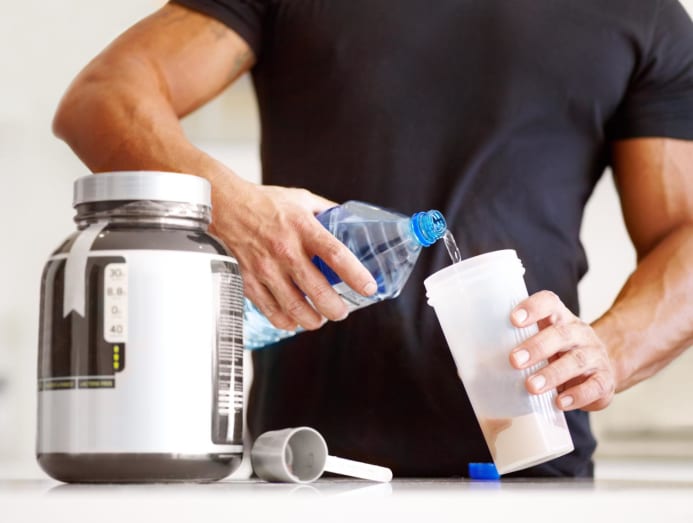
Scenario 7: I am trying to cut down on carbs and sugar to lose weight
If you’ve read this far, you might be wondering: Isn’t that a lot of glucose and carbs you have to eat to prevent exercise-related hypoglycaemia? Wouldn’t that cancel the weight loss you’re trying to achieve?
As Prof Tai mentioned earlier, there are medications that do not bring down your blood glucose level and it is worth speaking to your doctor about them. “Even for medications that do lower your blood glucose level, there may be a need to adjust them, so that you do not have to consume additional sugar in order to prevent hypoglycaemia when exercising,” he said.
By all means, cut down on white sugar and sources of processed carbs such as white rice, regular pasta and white bread in your diet as they promote undesired spikes in your blood glucose level. But carbs are not the enemy. “It is important to understand that carbohydrates are essential for optimal health,” said Cheryl. “Apart from situations to have sugar as a relief from hypoglycaemia, always opt for healthier complex carbohydrates in your meals and at appropriate amount.”
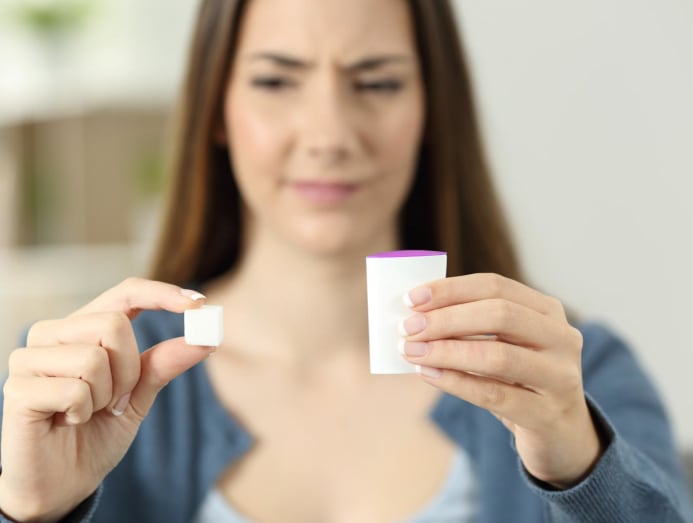
Here’s an example of an appropriate amount of carbs to have after an hour of aerobic exercise that typically burns about 455 calories, according to Mary-ann: 15g of quick-acting carbs from one glucose tablet or one tablespoon of honey in a cup of warm water. Then, follow through with 15g of long-acting carbs such as a slice of wholemeal bread with lettuce or tomatoes.
What about artificial sweeteners? Are they suitable for those with diabetes looking to lose weight? “The truth is that artificial sweeteners, when consumed, are processed differently by the body than regular sugar, which can interfere with the body's learned taste,” said Mary-ann.
“This can cause confusion in the brain and result in signals that trigger the desire to eat more, especially sweet foods. They can also alter gut bacteria, which is important for weight management. Therefore, for people with diabetes looking to manage their weight or sugar intake, it is important to note that artificial sweeteners may not be a good substitute,” said Mary-ann.










